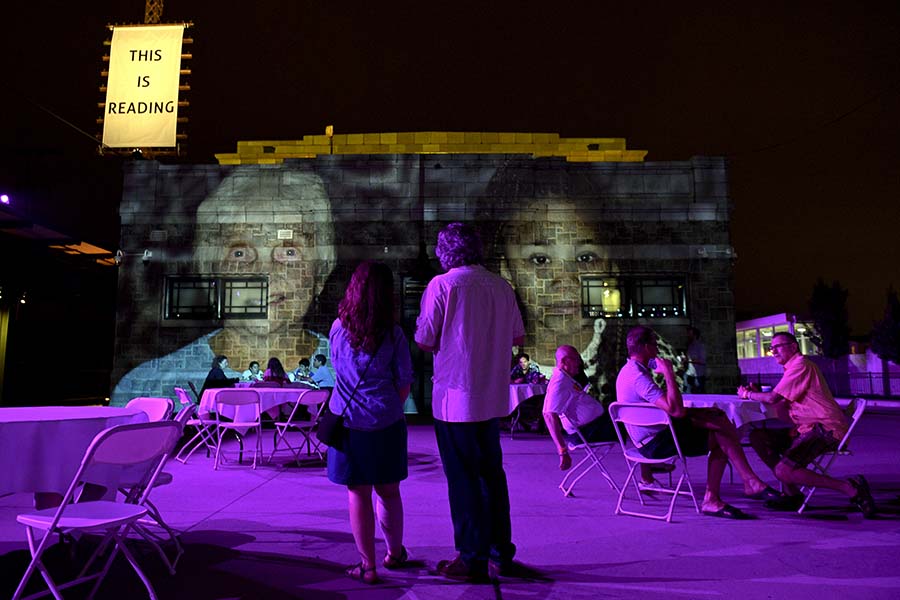As a child, I thought every city had anthracite culm heaps next to its welcome sign. I grew up in Dallas, Pa., a small town in the outskirts of the city of Wilkes-Barre. Black mounds of coal used to line the highway from Wilkes-Barre into Dallas, and this site of black hills set against the rolling Appalachians was home. These dunes were once the black diamonds in “The Diamond City”—but now the few remaining piles are reminders of what the city used to be.
When coal was king, Wilkes-Barre thrived. I heard about the decadent Hotel Sterling in the city’s center, with its famous guests from around the world and the delicious lobster thermidor served in its Palm Room restaurant. The Knox Mine disaster in 1959 marked the end of the coal industry in Northeastern Pennsylvania, and many of the major businesses shuttered. For all my life, the Hotel Sterling was windowless and inhabited by the homeless. A wrecking ball demolished the 115-year-old building when I was in high school.
I often heard about how grand the city had been when coal reigned, but I also learned about the thorny underside of the coal industry. My great-great-grandfather worked as a breaker boy and lost his leg in the mines when he was just 12 years old. The dark history of the coal industry and the nostalgia for the riches it produced are still fighting each other, smoldering in the few remaining mining sites.
Reading, Pa., about 90 miles south of Wilkes-Barre, is another town tinged with this double-edged nostalgia. When the coal industry was booming, Reading thrived too. Train cars of coal would travel from Northeastern Pennsylvania to the Reading Railroad Station, where it was distributed around the country along with the specialty goods manufactured in Reading’s many factories. But by the time I was a kid, it was already a shell of its former self. I remember how, when my family would drive to Reading to visit my father’s cousins, we’d often stop at clothing outlets, where racks of clothing and shelves of discounted goods stood inside the former factory buildings and manufacturing sites that once sustained the city’s economy.
This past weekend, my parents and I visited the Vanity Fair Outlets again. But this time we came for a piece art: an installation called “This Is Reading.” This seven-part multimedia show is a love letter to the city of Reading and to the steel factory workers who inspired Lynn Nottage’s Sweat. The Pulitzer Prize-winning play, which bowed on Broadway this spring, follows a group of Reading steel factory workers during the early-2000s deindustrialization of the Rust Belt city.
This Is Reading is up at the Franklin Street railroad station (July 14-16, 21-23, and 28-30), a stop on the defunct Reading Railroad. While Reading Railroad is immortalized on the Monopoly board, the Franklin Street station can’t be found on Google Maps—not even the postal carrier could point us in the right direction.
When we did arrive, I was greeted by Nottage and her hearty team of volunteers. There were strings of blue and purple lights illuminating the station, which closed in 1981. “We thought if we reanimate this space and bring it back, that symbolically it can sort of point to a rebirth in this city,” said Nottage.
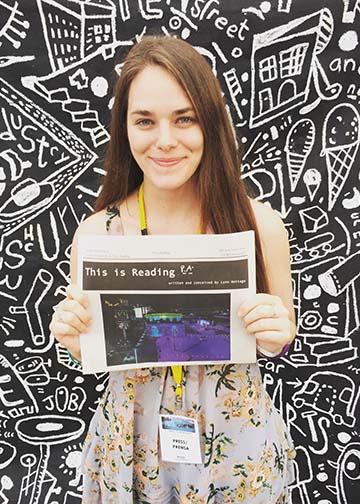
I sat with Nottage on the train platform before the show. She pointed to a palpable example of rebirth, a building adjacent to the station. It was painted with a black and white mural with doodled knobs, pulleys, factory lines, dollar signs, and pretzel twists—the story of Reading told in hieroglyphics. “We painted this mural on this building, which was a SRO [single room occupancy hotel], really struggling, and considered one of the real sore spots of the community,” said Nottage. “The people who live there were so excited that something was being done to their building that they poured out and helped the muralist (Katie Merz) paint. This one guy actually spent the week and a half that it took paint out there every single day with a paintbrush. All of them have come and seen the play. Just based on the little freshening up of the building, the landlord decided that he was going to replace some of the windows and paint the lobby.” Merz’s drawings also served as the backdrop for the program and site map, outlining the various rooms inside the station.
“I encountered a large swath of people who were living and thriving and making their home in Reading,” Nottage continued. “I wanted to do something that was very much in dialogue with them and figure out how to create a piece of art in a city that has fault lines—those fault lines are economic, and they are social, and they are racial.”
When I read Sweat, I thought of the fault lines in Wilkes-Barre. Both Reading and Wilkes-Barre fell victim to urban blight and floundered after their industry-based identities crumbled. I grew up in an area that struggled to move forward, stuck in the past.
“When we first came into Reading, one of the things that we always encountered was people speaking of the city in a very nostalgic way,” said Nottage. “Always speaking in past tense. We wanted to begin with that. What was this city? What was it that people were holding onto? Get through that and revisit the ghosts that are not only inhabiting this station but the entire city.”
Pre-show goodies included mini bags of local pretzels, frozen treats from a local ice cream shop, and local performers. A singer/songwriter roused the crowd with folk tunes. Next, a group of young Latin dancers in sparkly tulle took the stage. “The arts are alive in Reading,” effused the dance instructor. Entertainment continued inside the station before the scheduled showtime. I entered into the station, which was lined with an impressive amount of scaffolding and lighting plots, and bee-lined for “The Reading Room” (a pun on the city’s name, which is pronounced “redding”), stacked with shelves of sketchbooks on loan from Brooklyn’s Sketchbook Project. Hundreds of little notebooks were filled with drawings of historic sites by Reading-based artists. I joined a group of kids drawing in the blank notebooks and added a sketch of the train station to the page. In the station’s old lunchroom, piles of old suitcases were topped with screens showcasing interviews with Reading residents about the city.
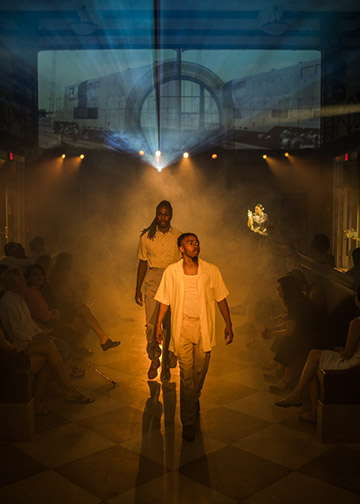
An announcement was made to take a seat—the train was about to leave the station. About 200 people settled on the station benches. A train whistle blew, and smoke billowed out from under the seats and along the station floor as performers from Reading and the LAByrinth Theater Company slowly entered the space in a line. First stop: the past, with a section called “Reading Was.”
Video showing the city in its heyday was projected on the station walls as the performers recited memories of growing up in Reading. Next up was a film titled “Behind Closed Doors,” by Tony Gerber with Market Road Films, which followed a girl’s quinceañera, a young woman’s day working at a chocolate factory, a masonic meeting, and a church service, all in Reading. The little girl seated behind me excitedly yelled, “That’s my grandma’s church!”
Nottage and director Kate Whoriskey (who directed Sweat at Oregon Shakespeare Festival, Arena Stage, the Public Theater and on Broadway) beautifully folded the audience into the stories of Reading’s past, present, and future.
“Reading is struggling in these little pockets of isolation,” Nottage told me. “And no one is really in dialogue, but everyone is suffering in equal measure. Everyone is passing blame across the various divides, so we decided to create a piece of art that puts everyone in Reading into the same room so that they can recognize that they share one narrative.”
In one particularly moving segment, interviews with residents were displayed on the station walls with projections by Jeff Sugg. Audience members who shared their stories of Reading in a booth before the show were displayed. An algorithm developed by Joe Bender and Pedro Moura aggregated the video clips together, and audience members whooped in excitement to see their faces projected. The best part of the experience for me was watching my parents’ faces from across the aisle, seeing them nod in recognition as the performers spoke about growing up in the ’60s, and noticing them wince when images of wrecking balls were projected on the walls.
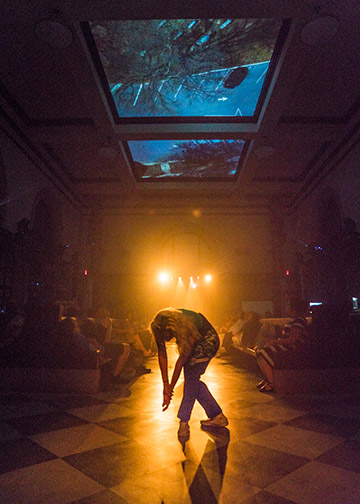
During “Reading Soars,” I rested my head on the bench and looked at the ceiling as images of Reading captured from a drone swirled above. Before the show, Nottage said that this section aimed to “shift perspectives and give Reading a beauty treatment.” While dancers were pictured dancing on building rooftops, dancers reemerged into the station to join their reflections on the ceiling.
Dance seemed to be the best way to capture the vibrant and diverse population of Reading today. The “Reading Lives” portion invited audience members to partake in the pulsating action choreographed by Rennie Harris. My mom was pulled from her seat to join the dancers.
Then the audience spilled out of the station in a dance line and into the rain for the final movement. People took cover under the station overhang, where a band played a percussive, marching beat. It sounded like a train in motion. Photos of audience attendees were projected on the outside station wall, and some audience members braved the rain and danced in the puddles. This section of the performance, created by Gerber with projections by Sugg, was called “Seeing Being Seen.” A man leaned out the window of the muraled apartment building. He was looking at the people watching the resurgence of Reading below—he was seeing being seen.
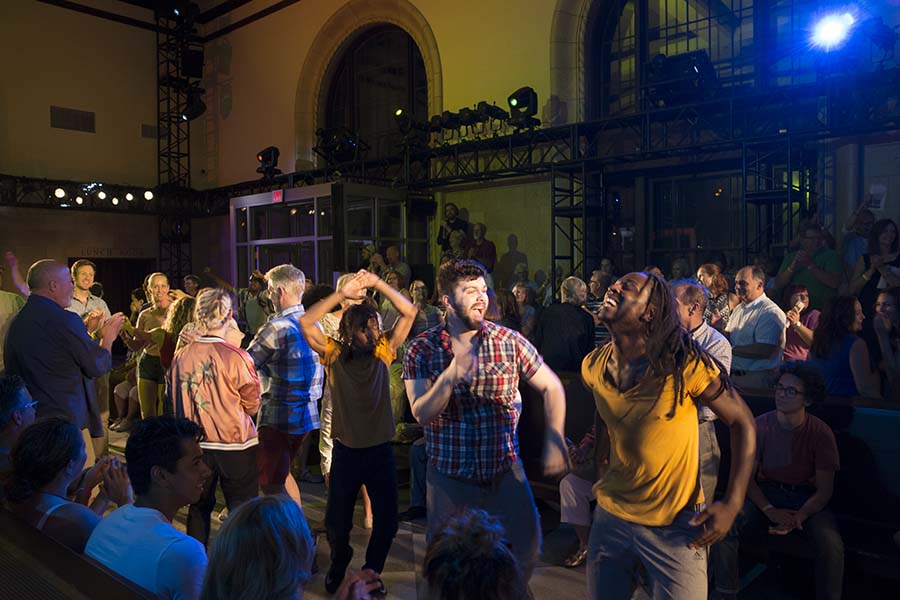
After the show, my parents and I retreated from the rain into a restaurant on Cherry Street in downtown Reading. The building, with its vaulted ceilings, was once a farmer’s market. My dad noted that if the building were in Wilkes-Barre, it probably would have been unappreciated and knocked down. But here it had been repurposed into a beautiful farm-to-table restaurant.
As we drove home in the rain, we passed the exit for the obsolete train station in Wilkes-Barre. I couldn’t help thinking about the magic that could happen if this station—whose copper roof was recently looted—was given the love and attention that Nottage and her team gave to the Franklin Street station. “This Is Reading” took a deep dive into what a nostalgic city was holding onto, and set the worthwhile parts back into motion. What if our country could forge more of these personal connections—ones that can reconnect the places once linked by railroad stations?
Creative Team & Cast
Lynn Nottage: Writer/Conceiver
Tony Gerber: Filmmaker/Co-conceiver
Kate Whoriskey: Director/Co-conceiver
Rennie Harris: Choreographer
Eli Evnen: Composer
Deb O: Environment designer
Jennifer Moeller: Costume designer
Amith Chandrashaker: Lighting designer
Nick Kourtides: Sound designer
Jeff Sugg: Projections designer
Katie Merz: Mural artist
Ty Inwood: Mural artist
Vanessa Aspillaga: Actor
Russell G. Jones: Actor
Michael Puzzo: Actor
*An earlier version of this story omitted the creative team credits.

